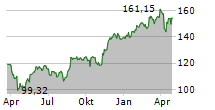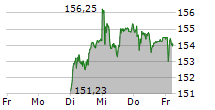
DJ Life insurance drives global premium growth as interest rates remain higher for longer, says Swiss Re Institute
Swiss Re Ltd / Key word(s): Forecast/Market Report
Life insurance drives global premium growth as interest rates remain higher for longer, says Swiss Re Institute
2024-11-19 / 10:00 CET/CEST
=----------------------------------------------------------------------------------------------------------------------
. Total global insurance premiums set to grow at 2.6% annually in 2025 and 2026, with elevated interest
rates, mainly in the US, supporting insurers' profitability
. Premium growth primarily driven by life insurance, which is forecast to grow globally by 3% per year,
more than double the rate of the past ten years
. Swiss Re Institute forecasts solid global economic growth of 2.8% for 2025 and 2.7% for 2026, while
geopolitical and financial risks are building up
London, 19 November 2024 - Global life insurance premiums are forecast to grow at an annual rate of 3% in 2025 and
2026, more than double the rate of the past ten years. According to the new sigma report "Growth in the shadow of
(geo-)politics", rising real wages, still elevated interest rates in key markets like the US, ageing populations, and a
growing middle class in emerging markets continue to support global demand.
Paul Murray, Swiss Re's CEO Life & Health Reinsurance, says: "The baby boomers are entering retirement at a time when
higher interest rates reinvigorate the insurance savings market. It's a favourable convergence, since retirees are
looking for stable and worry-free income, and the insurance industry is stepping up to meet this demand. Driven by a
still elevated interest rate environment in the US, global life insurance premiums are set to reach USD 4.8 trillion by
2035, up from USD 3.1 trillion in 2024."
Savings products: record sales in the US, strong demand in China
Consumers worldwide are taking advantage of still elevated interest rates. The growth trend is strongest in the US,
where individual annuity sales are expected to reach a new record of over USD 400 billion in 2024, well above the
USD 234 billion average of the past ten years.
The demand for fixed-rate annuities in the UK should also stay elevated in 2024 before slowing down during 2025 and
2026. In China, the anticipated reduction in guaranteed interest rates for savings products has been boosting sales.
This high demand is expected to persist in the medium term, driven by the appeal of longer-term savings products.
According to the sigma report, consumers in advanced markets will increasingly pivot from fixed annuities towards
index-linked policies in the following two years, as central banks lower interest rates. In Europe, unit-linked sales
are rising strongly this year, particularly in Italy and France. Swiss Re Institute expects this trend to expand to the
US and other markets from 2025. Index-linked policies are designed to provide returns that are tied to a specific
financial index, while unit-linked life insurance products invest in various market-linked funds, such as equities,
bonds, or a combination of both, while also ensuring life coverage.
Life risk protection stable, but growing below long-term trend
The life risk protection business has been growing more steadily than the savings business in recent years. Swiss Re
Institute forecasts 2.7% annual premium growth in 2025 and 2026, below the long-term trend of 3.7% per year from 2014
to 2023. The demand for protection products is generally less responsive to changes in interest rates, with re-pricing
slower to materialise, but the opportunity to grow the business remains.
According to the sigma report, European markets see robust demand for disability and long-term care insurance. Looking
ahead, the demand for risk protection will be driven by cyclical factors such as improving mortgage markets, and
structural trends like rising costs of healthcare and nursing services, an aging population as well as attractive
product bundling. In the US, individual life protection sales are expected to remain flat, while group life and health
sales are slightly more resilient, supported by strong employment levels and wage gains.
Non-life insurance: more profit, but less premium growth
Following the repricing of risk in response to elevated claims, Swiss Re Institute expects a decade-high 4.3% global
premium growth in 2024. In the following two years, premium growth is expected to decelerate, with global non-life
premiums forecast to grow 2.3% annually in real terms, below the 3.1% average of the last five years.
Further improvements in investment results from still elevated interest rates should support overall profitability of
non-life insurers. Swiss Re Institute forecasts an industry return on equity (ROE) at 10% in 2025 and 2026 in the six
largest non-life insurance markets, which would exceed the cost of capital.
Solid global economic growth, but significant regional divergences
Global economic growth is set to continue at a solid pace. Swiss Re Institute forecasts global real GDP growth at 2.8%
for 2025 and 2.7% for 2026, down from the 3.1% average growth of the pre-pandemic decade. However, there are
significant regional divergences and risks are skewed to more adverse scenarios amid heightened geopolitical tensions
and trade policy uncertainty.
Jérôme Jean Haegeli, Swiss Re's Group Chief Economist, says: "We see higher inflation risks and chances of less
interest rate cuts than previously assumed, particularly in the US given the election outcome and the continued strong
economy. Still elevated interest rates could further boost primary insurance markets, especially in life insurance, but
a more fragile overall economic environment and volatile geopolitical backdrop raises risks of adverse macro scenarios.
Early and proactive scenario monitoring will be critical for the insurance industry."
The US, Europe and China follow diverging paths
The US election outcome of 2024 could bring about greater divergences between countries in terms of growth, inflation
and central bank interest rate outlooks over the next two years. US growth exceptionalism is expected to continue, even
as sequential growth rates moderate. According to the sigma report, US real GDP is set to grow by 2.8% in 2024, by 2.2%
in 2025 and 2.1% in 2026 respectively. This growth is underpinned by still healthy US consumer fundamentals: Net wealth
is near record highs, up roughly USD 50 trillion relative to pre-pandemic (2019) levels, and recent GDP revisions show
greater savings than previously accounted for.
The European economies are at risk of being disproportionately affected by rising global trade tensions and the
resulting uncertainty. Europe is expected to underperform relative to the US and its own pre-pandemic trend. Swiss Re
Institute forecasts the Euro-area economy growing from 0.7% in 2024 to 0.9% in 2025 and 1.1% in 2026, with risks skewed
to the downside.
As the Chinese economy is expected to undergo a structural slowdown in the coming years, China's real GDP growth is
projected to moderate to 4.6% in 2025 and 4.1% in 2026. The recent monetary easing and fiscal stimulus measures
announced this autumn should help to shore up near-term business sentiment but are unlikely to solve longer-term
structural issues.
Table 1: Real GDP growth and CPI inflation forecasts, 2023 to 2026F
2023 2024F 2025F 2026F
Real GDP growth, Global 2.8% 2.8% 2.8% 2.7%
annual avg.
US 2.9% 2.8% 2.2% 2.1%
UK 0.3% 0.9% 1.2% 1.5%
Euro area 0.5% 0.7% 0.9% 1.1%
Japan 1.9% -0.1% 1.2% 0.9%
China 5.2% 4.9% 4.6% 4.1%
Inflation, all-items CPI, Global 5.8% 5.1% 3.3% 3.0%
annual avg.
US 4.1% 2.9% 2.5% 2.4%
UK 7.4% 2.5% 2.2% 2.3%
Euro area 5.5% 2.3% 2.0% 2.1%
Japan 3.6% 2.6% 2.0% 2.0%
China 0.2% 0.4% 1.1% 1.5%
F = forecasts. Data as of 11 November 2024. Source: Swiss Re Institute, Bloomberg
Table 2: Insurance premium growth forecast in real terms
Total Non-life Life
2024F 2025- 2026F 2024F 2025-2026F 2024F 2025-2026F
World 4.6% 2.6% 4.3% 2.3% 5.0% 3.0%
All 4.1% 2.0% 4.3% 1.9% 4.0% 2.0%
Advanced markets
North America 5.2% 1.9% 4.6% 1.9% 7.1% 1.8%
Western Europe 2.7% 1.8% 3.7% 1.7% 2.5% 1.9%
Asia Pacific 2.2% 2.6% 3.2% 3.0% 1.9% 2.5%
Emerging markets All 6.7% 5.3% 4.3% 4.1% 7.9% 5.7%
Excl. China 5.8% 5.1% 4.7% 4.2% 6.5% 5.6%
China 7.5% 5.5% 3.9% 4.1% 8.9% 5.7%
F = forecasts. Data as of 11 November 2024. Source: Swiss Re Institute, Bloomberg
How to order this sigma study:
Sigma 5/2024, "Growth in the shadow of (geo-)politics - global economic and insurance market outlook 2025-26" is available in electronic format. You can download it here.
(MORE TO FOLLOW) Dow Jones Newswires
November 19, 2024 04:00 ET (09:00 GMT)
© 2024 Dow Jones News




